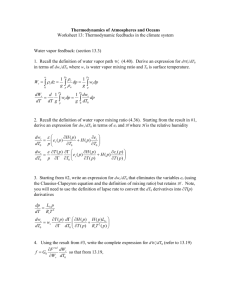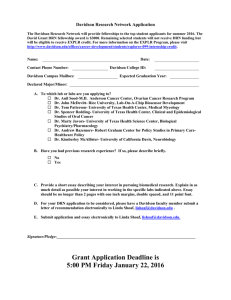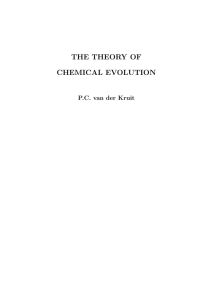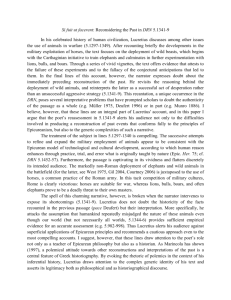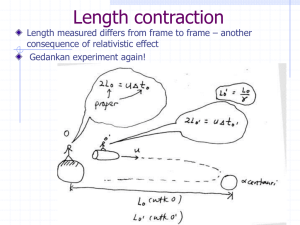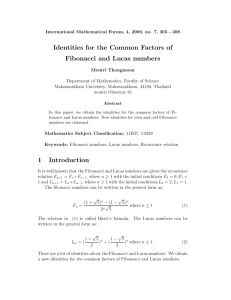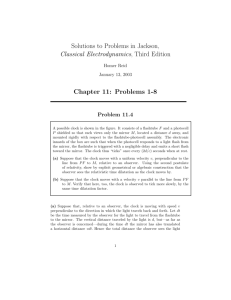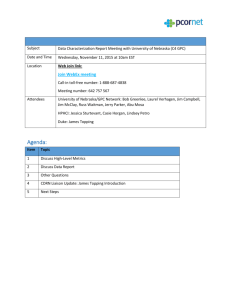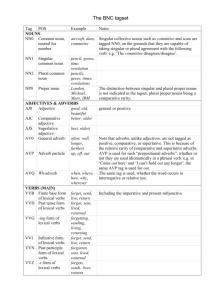IN SEARCH OF AN IDENTITY FOR THE DRN
advertisement
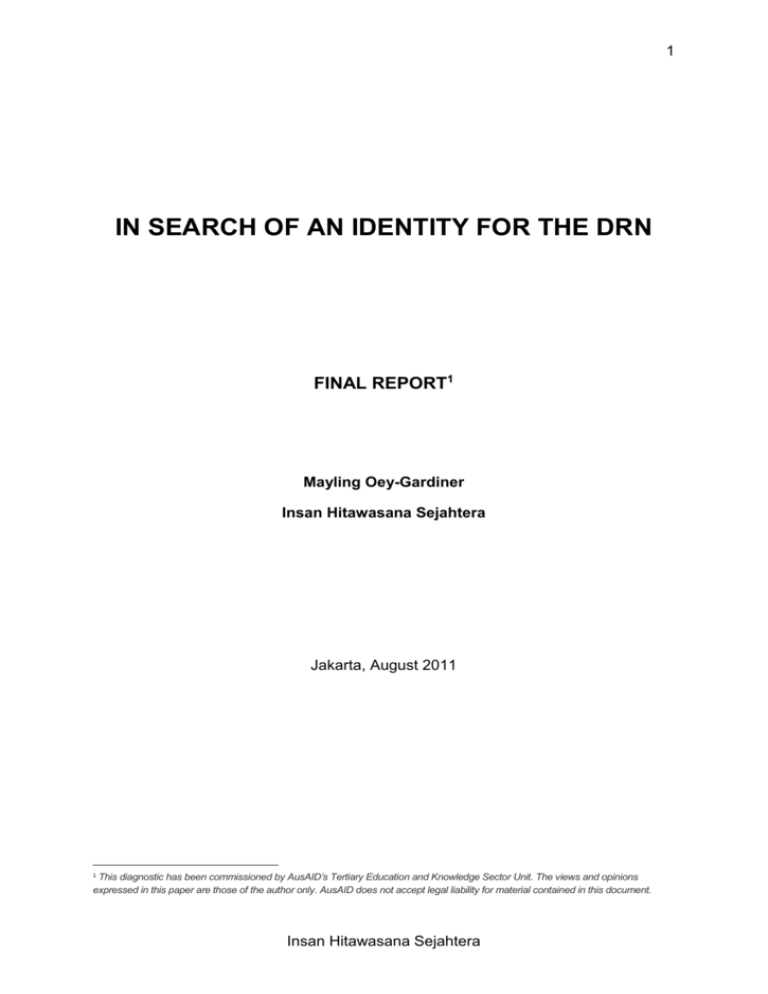
1 IN SEARCH OF AN IDENTITY FOR THE DRN FINAL REPORT1 Mayling Oey-Gardiner Insan Hitawasana Sejahtera Jakarta, August 2011 This diagnostic has been commissioned by AusAID’s Tertiary Education and Knowledge Sector Unit. The views and opinions expressed in this paper are those of the author only. AusAID does not accept legal liability for material contained in this document. 1 Insan Hitawasana Sejahtera 2 GLOSSARY ACRONYM INDONESIAN ENGLISH Academia, Business and Government Indonesian Academy of Sciences National Research Agenda Agro Tekno Park National Survey and Mapping Coordinating Board Research and Development Board Nuclear Energy Supervisory Board National Nuclear Technology Board National Standardizing Board Technology Investigation and Application Board Business Technology Center Regional Research Council National Research Council Science and Technology ITB Akamedia, Bisnis dan Pemerintah Akademi Ilmu Pengetahuan Indonesia Agenda Riset Nasional Taman Teknologi Agro Badan Koordinasi Survei dan Pemetaan Nasional Badan penelitian dan pengembangan Badan Pengawas Tenaga Nuklir Badan Teknologi Nuklir Nasional Badan Stadardisasi Nasional Badan Pengkajian dan Penerapan Teknologi Pusat Bisnis Teknologi Dewan Riset Daerah Dewan Riset Nasional Ilmu Pengetahuan dan Teknologi Institut Teknologi Bandung Jakstranas Kebijakan Strategis Nasional KADIN Kamar Dagang Indonesia KEN Komite Ekonomi Nasional KIN Komite Inovasi Nasional ABG AIPI ARN ATP BAKOSURTENAL Balitbang BAPETEN BATAN BSN BPPT BTC DRD DRN Iptek Kompas KRT LAPAN LBME LIPI Kementerian Riset dan Teknologi Lembaga Penerbangan dan Antariksa Nasional Lembaga Biologi Molekuler Eijkman or Lembaga Eikman Lembaga Ilmu Pengetahuan Bandung Institute of Technology National Strategic Policies Indonesian Chamber of Commerce National Economic Committee) National Innovation Committee Jakarta Daily Minister for Research and Technology National Aeronautical and Space Institute Eijkman Institute or Eijkman Molecular Biology Institute Indonesian Institute of Insan Hitawasana Sejahtera 3 ACRONYM Litbang MBB Meneg Menristek MOF MP3EI PEPUNAS PPh PPN PUSPA IPTEK PUSPITEK REPELITA RISTEK satgas SINas TIM ToR INDONESIAN Indonesia Penelitian dan Pengembangan ENGLISH Sciences Research and Development Messerschmitt-Bolkow-Blohm Menteri Negara Minister of State Menteri Riset dan Teknologi Minister of Research and Technology Minister/Ministry of Finance Masterplan Percepatan Indonesian Economic Pembangunan Ekonomi Development Acceleration Indonesia Master plan Perumus Program Utama National Program Nasional Formulation Team Pajak Pendapatan Income Tax Pajak Pertambahan Nilai VAT/Value Added Tax Pusat Peragaan Iptek Science and Technology Exhibition Center Pusat Penelitian Ilmu Science and Technology Pengetauhan dan Teknologi Research Center Rencana Pembangunan Lima Five-Year Development Plan Tahun Riset dan Teknologi Research and Technology satuan tugas work unit Sistem Inovasi Nasional National Innovation System Tim Team Terms of Reference Insan Hitawasana Sejahtera 4 CONTENTS Page 1. INTRODUCTION 1 2. OBJECTIVES OF THE ASSIGNMENT 2 3. METHODOLOGY 2 4. ABOUT THE DRN 2 Organizational History 2 Leadership 4 Membership in DRN 5 The Role and Function of DRN in Research 8 Funding for the DRN 10 5. IN SEARCH FOR AN IDENTITY FOR DRN 12 View from the Chair 12 View from Menristek 12 6. CONCLUSIONS AND RECOMMENDATIONS 17 Conclusions 17 Recommendations 17 BOXES 1. 2009-2011 DRN Tasks Stated in Minister of Research and Technology Decree No.001/M/Kp/I/2010 9 2. 2009-2011 DRN Tasks Stated in Minister of Research and Technology Decree No.76/M/Kp/II/2011 10 3. Underlying Weaknesses in DRN 16 4. Menristek Recommendations to Revitalize DRN 16 FIGURES 1. Composition of Commission Chairs Insan Hitawasana Sejahtera 7 5 Page TABLE 1. Changes in Status of DRN 3 2. Distribution of the 2009-2011 DRN Members by Commission and ABG Affiliation 7 3. Budgetary Comparisons of Central Government Expenditures, R&D Units, and the Ministry of R&T Insan Hitawasana Sejahtera 11 6 IN SEARCH OF AN IDENTITY FOR THE DRN FINAL REPORT Mayling Oey-Gardiner2 (Insan Hitawasana Sejahtera) August 2011 1. INTRODUCTION As part of the broader knowledge sector review being carried out under the Australia-Indonesia Partnership initiative for Revitalizing Indonesia’s Knowledge Sector for Development Policy this brief diagnostic report looks at the Indonesian DRN (Dewan Riset Nasional or National Research Council) that along with the range of government and non-government research-linked institutions forms part of the nexus of the knowledge network in Indonesia. In contrast with the other part of the assignment dealing with the Indonesian Institute of Sciences (LIPI), this overview of the DRN is not limited to the social sciences only but rather takes a view of the overall role of the institution in research while still paying special attention to the social sciences. The main reason for this has to with the size and nature of the DRN, which unlike LIPI is much smaller in size, constituting only a very small unit within the Ministry of Research and Technology and with only one full-time professional in an administrative position as that of Secretary and around 100 members of the various Commissions. The DRN budget is less than one percent of LIPI’s budget. If there is a similarity they share, it is a common neglect by the Head of State for research-based knowledge. A further delineation is in reaction to the plural form mentioned in the ToR in reference to Research Council(s). In fact, since decentralization, there is not only the DRN set up at the national level, but there is also provision for Regional Research Councils (Dewan Riset Daerah or DRD) established by local government at province and district level. This report, however, deals only with the national level DRN as there are still no standardized rules about local government structures, including about the existence of, or relations of the center with these DRDs. That means that a study of DRD’s would have required visits to existing DRD’s of which there are 26 at the provincial level and 6 at the district/city level (as reported to the author in a telephone communication on June 26, 2011), spread out throughout the country from Medan in North Sumatra to as far as Papua in the East. The budget for this assignment made no allocation for the purpose. 2 The author is currently a member of the DRN in the Technical Commission for Social Science and Humanities. Insan Hitawasana Sejahtera 7 2. OBJECTIVES OF THE ASSIGNMENT Based on the ToR, this review was intended to provide a broad overview of the DRN its roles, functions and scope of work and to put it in the context of the overall government knowledge environment including that covered in the report on LIPI. Among others, it included the following questions: What is the role and function of DRN in research? What is its scope of work? What and how much funding does DRN have (and how they spend it)? How in the above does DRN differs from LIPI? 3. METHODOLOGY “In Search of an Identity for DRN” is the story pursued through this overview of the institution. To elaborate this story, a similar approach and methodology was used here as in the earlier LIPI study. We relied mainly on secondary information available in the public domain as well as on information obtained from personal sources, including written responses to a specific request for information on the institute and its organization, as well as other notes and thoughts that might be better labeled as ‘work in progress’ papers. This information was further enriched with interviews and observations obtained during the author’s participation in commission and plenary meetings (considered of no harm when exposed to the public) and through follow-up informal communications. 4. ABOUT THE DRN Organizational History (see Table 1) The DRN had its origins in the TIM PEPUNAS RISTEK (Tim Perumus Program Utama Nasional Riset dan Teknologi or National Research and Technology Program Formulation Team) which was established in May 1978 to assist the new Minister for Research and Technology and in response to a felt need to provide greater direction for the various research activities being conducted by a variety of government and other research institutions in support of development priorities. Subsequently, in 1984, in the lead up to implementation of the 4 th Five-Year Development Plan (REPELITA IV, 1984-1989) the TIM PEPUNAS was reformulated and renamed as the Dewan Riset National under Presidential Decree No. 1/1984 dated 7 January 1984. In 1999 with the new government under President Habibie the task of the DRN was further modified to make it directly accountable to the President of the Republic of Indonesia and with the chair being assumed by the Minister of State for Research and Technology (Meneg Ristek). Further social and political changes in Indonesia led to a further revision of the DRN’s legal status through Law No.18/2002 on the National Research System, Science and Technology Development and Implementation as the formal-legal framework to strengthen the existence of DRN (2011 DRN executive agenda). This was then reinforced by Presidential Decree No. 16/2005 (KRT 2011). Insan Hitawasana Sejahtera 8 Table 1 – Changes in Status of DRN Pres Decree No.1/1984 Status Responsible directly to the Minister for Research and Technology MENRISTEK Decree No.xxx/1996 Responsible directly to the Minister for Research and Technology Pres Decree No.94/1999 Responsible directly to the President as Head of the Government Pres Reg. No.16/2005 DRN is an independent institution in executing its tasks Assist the Minister Main Tasks Assist the Minister for Research and Technology Assist the Minister for Research and Technology Assist the President responsible for research, development, and implementation of Science and Technology Provide considerations to the Minister in preparing strategic policies for national S&T developments Chair: Min of State for R&T Deputy Chair: Occupied on Chair: Min of State for R&T rotational basis between Chair/ Head of Non-Dept Deputy Chair: Occupied on Government Institution rotational basis between Chair: Minister responsible coordinated by the Minister Chair/ Head of Non-Dept for R&T for Research and Chair, Deputy Chair, and Government Institution Technology or Head Secretary of DRN are coordinated by the Minister Chair: Operational is by Organization Departmental R&D units, selected by the members for Research and appointment by the chair implementation of which is Structure according to rules Technology from among its members regulated by the Minister for established by the Board Research and Technology as Secretary: Assistant to the Secretary General: Selected Chair of DRN Minister for Research and from among its members to Technology for coordination, work full time Secretary: Assistant to the Formulation and Evaluation Minister for Research and of Main National R&T Technology for coordination, Policies and Programs Formulation and Evaluation of Main National R&T Policies and Programs Appointment Funding Membership in DRN is by appointed by the President as Head of Government on Members in DRN are recommendation of the appointed and dismissed by Minister in charge for R&T as the Minister Chair of DRN Membership in DRN and Work Groups are appointed by the President on recommendation of the Minister for Research and Technology as Chair of DRN Funding sources for DRN activities come from: 1. National Budget for S&T The budget to support the 2. Revenue from the public DRN work program is 3. Cooperation with 3rd party, charged to the budget of the domestic as well as office of the Minister for overseas Research and Technology 4. Other sources of funding allowed by existing rules and regulations Budget to support the DRN work program is charged to the Budget of the Office of the Minister responsible for R&T All financial requirements to conduct DRN tasks are charged to the National Budget through the Budget of the State Minister for R&T Source : Kementerian Riset dan Teknologi, Kedeputian Bidang Kelembagaan Ilmu Pengetahuan dan Teknologi (2011). Insan Hitawasana Sejahtera 9 Leadership It has often been found that the importance of leadership in the existence and status of an organization cannot be understated and this is particularly true for the DRN. The birth of the DRN (as well as on a national emphasis on the role of science and technology in development) was almost entirely due to the initiative of one man, Dr. B.J. Habibie. As a highly talented technologist (he graduated summa cum laude from the University in Aachen, Germany) and with the experience of heading an important high-tech German company in the aerospace industry, Habibie was highly aware of the value of research-based knowledge and information. He also had close relations with the then President Suharto where they both shared a dream of building Indonesia’s own aerospace industry PT Nurtanio and for the first four years in the mid-1970s he worked as a special assistant to the President while simultaneously maintaining an important and prestigious position in the aviation industry as Vice President and Technology Director at Messerschmitt-Bolkow-Blohm or MBB Hamburg, commuting between the two countries. However, in 1978 he returned full time to Indonesia to take up an appointment as Minister of State for Research and Technology (Menteri Negara Riset dan Teknologi/Meneg Ristek) and simultaneously the chairmanship of the BPPT (Badan Pengkajian dan Penerapan Teknologi, Technology Investigation and Application Board)3 (Nusantaranews April 2, 2009). He kept these positions for the next 20 years until 1997 and it was here, in his Ministerial capacity, having the ear of the President and being fully aware of the value of research-based knowledge that he took the nascent TIM PEPUNAS and converted it into the DRN in 1984. In fact, as noted above when BJ Habibie took over the Presidency in 1998, the DRN status and tasks were elevated so that the organization was directed to directly report to and assist the President (Presidential Decree No. 94/1999). However, the current country leadership since 2004 and, now in power for a second term until 2014 appears to rely to a lesser degree on research when making decisions and/or policies. Writing at the end of June 2011, the media discussed the President’s approach to solving problems in an ad hoc manner, ignoring existing institutions in favor of setting up committees and/or work units (satgas for satuan tugas).4 These ad hoc units are established to accomplish specific tasks assigned by and are accountable directly to the President. Membership is often inclusive, with members drawn from a variety of backgrounds considered to represent ‘stakeholders’ of a particular task, ranging from professionals to activists and at times 3 The current Secretary of DRN still remembers Mr. Habibie explaining why he named the institution BPPT. He intended for Indonesia to make a technological leap forward. And thus, Indonesia or more specifically BPPT could not afford to conduct basic research, but rather had to focus on the investigation of existing technology to be applied to future uses. 4 Currently the most widely cited committees are KIN (Komite Inovasi Nasional or National Innovation Committee) and KEN (Komite Ekonomi Nasional or National Economic Committee) that were supposedly established to speed up economic development within the context of a new development paradigm: MP3EI (Masterplan Percepatan Pembangunan Ekonomi Indonesia or Indonesian Economic Development Acceleration Masterplan). Ironically, KIN, which can be assumed to have the ear of the President, is located in the Ministry of Research and Technology. Both MENRISTEK and KIN are tasked to promote and/or strengthen innovation within the context of SINas (for Sistem Inovasi Nasional or National Innovation System) as ‘engine’ of MP3EI. Insan Hitawasana Sejahtera 10 also academics and business people. This situation arises from current political conditions where the President rules by a coalition and Ministries are shared among political parties instead of having leadership positions assigned to independent professionals. Thus party politics overrules practices of research-based public policy making and where research institutes are there to be left alone instead of relied on for advice. In short, it is suggested that current political conditions do not favor DRN’s status. Presently, DRN operates legally under Presidential Decree No.6, 2005, responsible to and reporting to the Minister of Research and Technology. Compared to the earlier legal standing, this latter decree is indicative of a ‘demotion’ for DRN: from reporting to the President it now reports to the Minister. And as shall be shown later, even within the context of the Menristek, the role and function is being reduced even further within the short time of the first two years of the most recent Minister. Even though it is located with the Menristek, the DRN is actually supposed to be a non-structural and independent institution. The DRN is established by the government to gather ideas and visions from a variety of stakeholders related to developments in science and technology. It is not clear, however, how the independence of the institution can be established when its main task and function is primarily one of assistance to the Minister of Research and Technology in formulating the main direction and priorities of science and technology development. In addition, the DRN is also tasked with providing inputs to the Minister in designing national development strategic priorities in science and technology (Wikipedia on the DRN, last updated on 23 July 2008). And, as is discussed below, limited resources prevent the DRN from exercising virtually an functions independent of the Menristek. Instead, the DRN mainly works following the demands and needs of the Menristek.5 Membership in DRN Membership in DRN is by invitation and/or appointment. Members are nominated to represent government, research and development, academia and business. Members are initially nominated for a period of three years with the possibility of extension for another term. Nominations are proposed by current members of the Technical Commissions6 of which there are eight: (1) Food Security, 5 For example, the DRN did take into account a request from the Minister to prioritize research institutions that the Ministry coordinates when selecting the 2010 Research Incentive grantees that generally do favor universities. The MENRISTEK coordinates the following research institutions: (1) Lembaga Ilmu Pengetahuan Indonesia (LIPI); (2) Lembaga Penerbangan dan Antariksa Nasional (LAPAN); (3) Badan Pengkajian dan Pererapan Teknologi (BPPT); (4) Badan Teknologi Nuklir Nasional (BATAN); (5) Badan Pengawas Tenaga Nuklir (BAPETEN); (6) Badan Koordinasi Survei dan Pemetaan Nasional (BAKOSURTENAL); and (7) Badan Stadardisasi Nasional (BSN). In addition, the MENRISTEK also coordinates and manages the following institutions: (1) Pusat Penelitian Ilmu Pengetauhan dan Teknologi (PUSPIKTEK) in Serpong; (2) Lembaga Biologi Moekuler Eijkman or Lembaga Eikman (LBME); (3) Pusat Peragaan Iptek (PUSPA IPTEK); The Agro Tekno Park (ATP) in Palembang; (5) the Business Technology Center (BTC); and (6) Bio Island (Wikipedia, last revised 14 June 2011). 6 Based on the latest information the procedure is as follows. New potential members are identified and discussed during Commission meetings and then are proposed to the Chairs during leadership meetings. However, there are current talks going on to ‘revitalize’ the DRN and under any new format, methods for choosing new members have not yet been discussed. In any case, the DRN remains an Insan Hitawasana Sejahtera 11 (2) New and Renewable Energy, (3) Transportation Technology and Management, (4) Information and Communication Technology, (5) Defense and Security, (6) Health and Medicine,7 (7) Basic Sciences; and (8) Social and Humanities. There are no fixed rules on selection of new members. In spite of recognition of the need for strengthening the three pillars of technological developments – ABG for academia, government and business – identification of new members for the technical committees tend to be from the own networks of existing members. And thus when most members come from academia, they tend to nominate others also with academic backgrounds and/or affiliations, some of whom may (also) hold bureaucratic positions at the time of their appointment to DRN membership. There are also members who are selected from the business community, at times identified from among members of the Indonesian Chamber of Commerce (KADIN). These provisions do provide a background for the Ministry to play a role in closing the gap between research and commerce, in particular through the process of including representation of the business community in the DRN. In the current 2009-2022 term of the DRN there are a total of 100 members (Table 2). These members are distributed between the eight Technical Commissions which vary in size between 9 to15 members. Academia is generally well represented with some 36 members and another 19 members represent the government research and development units (mostly from balitbang).8 This is reinforced with some 29 members holding public sector structural posts of whom half are appointed in their personal cum professional capacity but currently hold structural positions in government, while the other half are appointed for their public positions (ex officio). Another fifteen members represent the business community of users: 5 coming from state companies and another 10 coming from the private sector. Only 1 member comes from the media. The composition of the DRN membership demonstrates the relatively low priority of research credentials among its membership. On the other hand, this composition is in line with the organization’s focus which is on tasks to develop cooperation between academia-business and government. In summary, the membership composition shows that attempts to break down the barriers between academia and commerce are moving on. Even though still dominated by academia, one of six members comes from the business community. However, it should be noted that government still remains dominant among committee chairs with six of eight chairpersons holding structural positions in government and only one each representing academia and the business community. institution of the MENRISTEK and final appointments of new members are ultimately made by the Minister. 7 The first six technical commissions follow the six ‘focus areas’ of the Minister of Research and Technology. In addition there are two commissions dealing with supposedly ‘cross-cutting’ issues as ‘basic research’ and ‘social sciences and humanities’. 8 It should be noted that because the DRN is not a research institution, neither are members generally selected for their research activities and/or research track record. Insan Hitawasana Sejahtera 12 Table 2 – Distribution of the 2009-2011 DRN Members by Commission and ABG Affiliation Percent Distribution Commission Food Security New & Renewable Energy Transportation Technology and Management Information and Communication Defense and Security Health and Medicine Basic Sciences Social and Humanities Total Total No Bus Media 7 14 9 11 Gov 29 36 Res 14 18 Acad 50 36 40 13 20 27 - 15 36 21 25 33 9 29 7 36 8 11 45 19 36 21 50 44 36 36 21 14 17 11 9 15 7 1 14 14 12 9 11 100 Source : DRN (National Research Council), Executive Agenda. According to current rules, the leadership is elected by and from among the members. The DRN chair, deputy chair and secretary are elected during a plenary meeting; while technical committee chairs and deputy chairs are elected by and from among committee members. In addition, it so happens that the overall DRN leadership is structured to represent each of three segments of the community: the Chair comes from Academia (ITB), the Deputy Chair represents the private sector and the Secretary comes from the government, specifically from BPPT. They also come from different committees – the Chair is a member of the Defense and Security committee, the Deputy is a member in Information and Communication Technology, and the Secretary is a member of Transportation Technology and Management. Figure 1 – Composition of Commission Chairs Source: DRN 2010 Even though a similar procedure is also applied in selection of Committee Chairs, there is a tendency, as noted earlier, for these positions to be dominated by government officials. Six of the eight commission chairs are occupied by bureaucrats, with the remaining shared by academia and business (Figure 1). This Insan Hitawasana Sejahtera 13 composition suggests that in fact, the leadership represents neither the research community nor the business community. And thus if the expectations are for an increased participation of the business community in science and technological developments, there still remains a long way to go. The Role and Function of DRN in Research The weakening position of DRN alluded to earlier appears to be not just occurring at the national level but but also within the Ministry of Research and Technology itself. As noted earlier, at one level, the DRN has been weakened by moving the level of reporting from the President to the Minister of Research and Technology. Moreover, it is suggested that the position of DRN has been further weakened in the recent past by the Minister through additional withdrawals of tasks assigned to the DRN which could be considered instruments for the DRN to exercise its authority, particularly in ensuring adherence to the National Research Agenda prepared by DRN. It should be stressed that the DRN is not a research institution; and, as explained earlier, while the DRN does include researchers among its members, one’s research track record is not a criterion for selection or inclusion into DRN. Even so, the current DRN of 2009-2011 defines its tasks in reference to Presidential Regulation No.16/2005 as follows: (DRN Executive Agenda): To assist the Minister in formulating the direction and main priority research development in Science and Technology (S&T); and To provide considerations to the Minister in preparing strategic policies for national S&T development. The first priority of these tasks has been translated as DRN spelling out the National Research Agenda (NRA)9. The NRA is an exercise of further detailing the focus areas of the Menristek which cover the same substantive areas as those covered by the first six technical commissions: (1) Food Security; (2) New and Renewable Energy Sources; (3) Transportation Technology and Management; (4) Information and Communication Technology; (5) Defense and Security; and (6) Health and Medicine.10 This exercise is prepared by DRN members, during commission meetings and is completed by the Chairs (mostly people from the Menristek) and legalized as a Ministerial Decree.11 9 DRN, Agenda Riset Nasional 2010-2014. Basic Sciences and Social and Humanities topics are only peripheral to the Ministerial structure, supposedly characterized as ‘cross cutting’ issues. Regrettably, especially the latter, social sciences and humanities are simply not important to the Ministry, which does not seem to understand that the degree to which technology leads to value or disaster is dependent on and determined by people who, in fact, represent the more important component of technological research. Thus, an earlier unit in the Ministry, seemingly designed to accommodate the social sciences and humanities (Social Dynamics) has been eliminated, even though it is said to have been replaced by a deputy for ‘Scientific Institutions’. 11 The latest ARN 2010-2014 is legalized as Keputusan Menteri Negara Riset dan Teknologi Republik Indonesia Nomor 193/M/Kp/IV/2010 tentang KEBIJAKAN STRATEGIS PEMGANGUNAN NASIONAL ILMU PENGETAHUAN DAN TEKNOLOGI 2010-2014. (Decree of the Minister of State for Research and Technology of the Republic of Indonesia No 193/M/Kp/IV/2010 on Strategic Policy on Science and Technology National Development 2010-2014). 10 Insan Hitawasana Sejahtera 14 This NRA is supposed to serve as guide for research conducted by numerous research institutions throughout the country; mostly established and managed by the government. These include LIPI, the institutes coordinated by the Ministry of R&T (see fn 4), R&D units in sectoral ministries and local governments, as well as research arms in public and private universities. The NRA is placed within the public domain and is available on the Web. However, the DRN has no resources to ‘enforce’ researchers and potential researchers to ensure they follow the NRA as a guide for selection of topics.12 In fact, it was probably only during the period when the DRN was tasked to conduct the selection of beneficiaries of the Research Incentive Program of the Menristek (see the Minister of Research and Technology Decree No.001/M/Kp/I/2010 in Box 1) that reliance on the NRA as reference and guide became more or less compulsory. In 2010, the selection of Incentive Research proposals13 was an important exercise carried out by all commissions and members of DRN, especially as these proposals had to reference the NRA. In this regard, tasking the DRN with the selection of research proposals under the Incentive Research Program did serve as an instrument to ensure compliance with the NRA, an important identity for DRN. Box 1 – 2009-2011 DRN Tasks Stated in Minister of Research and Technology Decree No.001/M/Kp/I/2010 1. Prepare the National Research Agenda (NRA) 2. Ensure implementation of the NRA through the following instruments: a. Manage the substance of the Incentive Research Program b. Coordinate research, development and application of science and technology between Academics, Business and Government; c. Coordinate and partner science and technology research activities between institutions at the national and technological levels; 3. General monitoring of science and technological developments; 4. Maintain scientific norms in science and technology; and 5. Develop a system and propose science and technology research awards. Unfortunately, in 2011 the Minister decided to withdraw these ‘implementation instruments’ as part of their authority that were earlier awarded to the DRN by deleting item no 2 in the 2010 Decree. This is reflected in Decree No.76/M/Kp/II/2011 (Box 2). Thus, DRN is no longer in charge of processing the selection of research proposals under the Incentive Research Program. Neither is there a role for DRN to play as a coordinator for ABG, even if it is still limited in scope, to become a reality; nor is there a role for DRN to play as a mediator between The weakness of the NRA as a ‘guide’ for research conducted with public funding is reflected in the results of a research activities mapping exercise carried out by the DRN (DRN, 2007, Pemetaan Kegiatan Riset Periode Pelaksanaan 2006-2007). 13 The MENRISTEK Research Incentive Program (RIP) provides larger amounts that those generally available to researchers in LIPI. While the LIPI thematic research projects are funded on the order of 100 million IDR, those under the RIP generally received closer to 300 million IDR. 12 Insan Hitawasana Sejahtera 15 research institutions. Withdrawal of these roles for DRN can be said to have strongly weakened the position of DRN in the country. Box 2 – 2009-2011 DRN Tasks Stated in Minister of Research and Technology Decree No.76/M/Kp/II/2011 1. Assist the Minister in formulating the main direction and priorities in developing Science and Technology and prepare the National Research Agenda 2. Provide considerations to the Minister in preparing the Science and Technology Strategic Policies (Jakstranas Iptek), the National Innovation System (SINas)14, and other Science and Technology strategic policies. 3. General monitoring of national Science and Technology developments. 4. Establish national scientific research norms 5. Nominate recipients for research awards to the Minister. Up to now, however, the current Ministerial Decree of 2011 still tasks the DRN with the preparation of the NRA. The Decree also specifies further potential provision of input by the DRN, but, as stressed above, with no possibility of ensuring its implementation and/or enforcement. This situation raises questions as to the DRN’s stature in the research community, given the continued weakening of its role and function by the Ministry. Even the tasks assigned in the 2011 Decree are difficult to implement. The most important constraint concerns resources. As mentioned earlier, there is only one paid full-time position in the DRN, that of the secretary, responsible for administration and with little or no time available for professional work. And as discussed below, the council is poorly funded with no resources available to conduct any activity of significance. Funding for the DRN As a government institution, the DRN derives its funding from the public sector. In line with its limited role and function, the DRN is also poorly funded. The DRN’s budget for 2011, which has to fund all of its activities, is only 5 billion IDR, and of this, the institute has been told by MOF that it has to save 10 percent to partially cover budgetary shortages. Moreover, we have been told, this amount should be further reduced by a significant proportion to cover taxes 15. If this is true, it leaves less than 4 billion IDR remaining for all operational expenses. 14 No official definition of SiNas is available. However, in his opening statement to a joint GermanIndonesian workshop on the National Innovation System held on 29 March – 1 April 2010 Minister Suhana stated that, “there are three basic elements which serve as the basis of SiNAs – education and training capacity, investment capacity and institutional innovations.” To explain a national innovation system in research, Usman defines SiNas as “constituting cooperation among a group of diverse agencies, all individually contributing for the development and diffusion of the latest science and technology through public sector policies in the innovation process” (Ramly Usman, 2002). 15 The following taxes are imposed on the DRN: (1) PPN (VAT) – 10%; (2) PPh21 (personnel/staff income tax) - 15% along with PPh22 (corporate/institution income tax) and (3) on average of 2% for Pajak Barang dan Jasa (goods and services tax). Insan Hitawasana Sejahtera 16 We can place the DRN budget in the broader context of the national budget, central government expenditures, allocations to all government R&D units, and the Ministry’s budget.16 This is done in Table 3. Due to the vast contrast in budgetary allocations to research in general and to DRN in particular, public budgets in Table 2 are presented in absolute terms only, rather than in terms of comparisons such as percentages or proportions. As can be seen, the 2011 Total Budget amounted to 1,229.6 trillion IDR, Central Government Expenditures amounted to some 836.6 trillion IDR, and the total for R&D Units (Litbang) amounted to some 4.6 trillion IDR. Against this the miniscule size of the DRN budget of around 4 billion IDR becomes clearly evident. Table 3 – Budgetary Comparisons of Central Government Expenditures, R&D Units, and the Ministry of R&T (in trillion IDR) 2005 2006 2007 2008 2009 2010 2011 Total Budget 509.6 667.1 757.6 985.7 937.4 1,126.1 1,229.6 Gov Exp 361.2 440.0 504.6 693.4 628.8 781.5 836.6 R&D units 1.4 0.8 0.9 1.2 0.8 1.2 4.6 MENRISTEK 1.4 0.3 0.4 0.5 0.4 0.7 0.7 0.001 0.001 0.003 0.003 0.005 0.005 0.004 DRN Source : Kementerian Keuangan Republik Indonesia, Data Pokok APBN 2005-2011 (see Appendix 1 for further details) Note : *All reduced by tax of 15% and for 2011 further reduced by 10% for savings and 650 million for purchasing a vehicle for the institute With such extreme limitation on funding and in line with reduced assignments from the Menristek, DRN activities are now rather limited. As is the case with other government institutions, operational expenses take priority, leaving a much smaller proportion of funds for actual program activities. As a central government agency, the DRN budget must cover salaries, capital goods and consumables necessary for its operations. Specifically the budget has to cover the salaries of the full-time Secretary and a number of administrative and support staff. It also has to cover consumables and additional equipment, including office equipment and vehicles. After the above operational requirements are fulfilled there is not much left for program activities. Thus the DRN members are only allowed to hold a limited number of meetings during the year consisting of six committee meetings along with two seminars that are allowed to cater to a slightly wider audience. Twice a year the overall council holds plenary meetings. Seminars are also extremely limited and can generally be attended by at the most some 30 participants. In addition, under current conditions it is not clear how the council actually interacts with the Minister (or Ministry). It appears, but could not be confirmed that in practice it is only the leadership which may have an audience with the Minister. Neither are there budgetary allocations for implementing the tasks assigned to DRN under the 2011 16 Because public allocations to research are so miniscule, we avoid comparisons here with GDP but rather focus on comparison to the size of the budget. Insan Hitawasana Sejahtera 17 Ministerial Decree. And thus, any exercise to implement the tasks assigned can only be done as desk exercises. 5. IN SEARCH FOR AN IDENTITY FOR DRN View from the Chair In his opening speech at the first 2011 plenary meeting of the DRN, the Chair, Professor Andrianto Handojo, Ph.D., noted his concerns about the role of the DRN on the national research scene as reflected in the following statements: “Of course our large country has big problems, requiring all of our attention. The big problems include research, research policy, implementation and management. In this regard, to turn the wheel of research and development activities, DRN plays an important role. First, it is tasked to assist the Minister of Research and Technology in formulating policies, however for that purpose, it is necessary to study ongoing developments and also try to support continuity in implementing Research and Technology policies. In this regard DRN has prepared a National Research Agenda or ARN which hopefully serves as collective guide to all researchers in the country. However, as we observe, not all, or not many consistently use it as reference. Triggered by that situation, DRN is currently considering improvements or strengthening its role to better support efforts to unify the spirit and move between researchers, including different Ministries.” (Puspitek, Serpong 16 June 2011) Also rather telling was the mood reported by in the media with the following headline: “Reset Nasional: Agenda dan Hasilnya Kurang Dikenal” (National Research: The Agenda and Its Results Are Not Widely Known). This was the impression also gained from a statement by the Deputy Chair, Betti Alisjahbana that “the ARN needs to be socialized and more importantly empowered” (Kompas 17/6/2011). These concerns are in line with the status and position of DRN in terms of its relation to the Minister as discussed above. View from Menristek An attempt to understand the potential (structural/legal) weaknesses of DRN within the context of the Ministry can also be gained from a recent Menristek document ‘Revitalisasi Dewan Riset Nasional’ (Kementerian Riset dan Teknologi, Kedeputian Bidang Kelembagaan Ilmu Pengetahuan dan Teknologi,17 2011). It should be noted that the author of this report also chairs the ‘Food Security’ committee of DRN. In addition, this is a very current report written within the current MENRISTEK perspective. It shows how the current MENRISTEK sees no need for and thus has eliminated the social sciences as an area of key concern. This is a very strong deviation from the school of thought of the DRN’s founder, Prof. BJ Habibie and a feature which is still strongly recognizable in AIPI (the Indonesian Academy of 17 Insan Hitawasana Sejahtera 18 Among others the document deals with SINas (Sistem Inovasi Nasional or National Innovation System) which is supposed to constitute the Menristek response to the realized low public appreciation for technology. The report acknowledges that “This concern arises from the: (1) miniscule national and local budgetary allocations for S&T development activities; (2) limited utilization of domestically developed S&T in the production of goods and services; and (3) limitation in numbers of workers promoting technological developments. SINas is supposed to change all that18. Basically, “there shall be no more research for the sake of developing knowledge. Instead, research is to be directed at directly contributing to relevant technology for potential users.” The Ministry envisions this as “the need to change the ‘mindset’ of technology developers – i.e. academics, researchers, engineers – to take a more commercial perspective”. This concept is not to be translated as “the producers of technology having to commercialize their products themselves but rather that they are responsive to commercial needs of technology. SINas is a complex system; it hopes to create a stage bringing together both sides of the spectrum – supply and demand for domestically produced technology” (KRT 2011: 1-2). In regards to the DRN the report notes that the ‘not optimal’ role of DRN is attributable to: “(1) an absence of a common perception on the position, role, tasks and function of DRN; (2) an impression that DRN is tasked but not provided by with the necessary authority to execute its function as an independent institution to support science and technology developments in Indonesia; (3) it being not always simple for the DRN to synchronize academic trends and assigned policies; and (4) the coordination of science and technology research with other institutions not being properly accommodated in the existing structure” (2011:9). The report further states that “… in fact there are more fundamental problems faced by DRN. These are: (1) The NRA is not really relied on as guide by the various research agencies, except when unavoidable (my emphasis) for those research activities funded through Menristek which demand reference to the NRA (my emphasis); and (2) Institutionally DRN does not fully support a research orientation to realize the SINas, the Ministry’s program, which is claimed to be compatible with real needs for making available technological solutions for real problems” (2011:9). And thus the report notes that to ameliorate the problem of DRN it is necessary to introduce basic fundamental changes. These include the potential for Sciences) which he also simultaneously established. AIPI includes five committees of which two are socially oriented: (1) Basic Sciences, (2) Medical Sciences, (3) Engineering Sciences, (4) Social Sciences, and (5) Culture. 18 SINas is the response of Menristek to ongoing research by scientists. In a way, it is a reaction to scientists continuing to conduct ‘basic research’ instead of ‘applied research,’ particularly the types of research that can mobilize industry. While individual research projects received limited funding, the research mapping exercise conducted by the DRN (2007) also showed a high level of repetitiveness among projects, most still carried out at very basic levels and with virtually no networking and thus no potential for reaching any economies of scale in the use of funds. Menristek’s objective is for diffusion of research outcomes and, in line with global developments, for continuous innovation to stay abreast of global competitiveness. Thus Menristek scientists are trying to warn the future developments lie with science, through innovation, to remain competitive in a rapidly globalizing world (Usman 2002, Suhana 2010, Wicaksono 2011). Insan Hitawasana Sejahtera 19 revising the rules and regulations underlying the existence of DRN, and second, it shall also be necessary to restructure DRN, which it seems can be translated as the need to introduce drastic changes in the composition of the members. Of course DRN’s existence is heavily dependent on Menristek, for the DRN is a unit of the Ministry. Even though, as mentioned earlier, DRN is supposed to report directly to the Minister, as shown in Appendix 2 (Organizational Structure of the DRN 2009-2011) the DRN’s rather low position in Menristek renders communication between the DRN and the Minister as a relatively big jump in bureaucratic terms. The DRN Secretary’s position (the only paid leadership position occupied by a professional19) is at the same level as the Section Head for DRN Administration, an Echelon 3 position within the Ministry,20 and below the level of the head of the Planning Bureau (Echelon 2), which is in turn a unit of the Secretary to the Minister (Echelon 1). Usually, in most other ministries, including non-portfolio ministries, Echelon 3 personnel hardly, if ever get to meet with the Minister to discuss official business.21 The low structural position of the DRN Secretary in the current bureaucracy is another factor leading to the DRN’s low stature within the Ministry and its extremely limited authority to effectively demand adherence to any of its products including the NRA.22 Moreover, the President has established two committees to provide him with advice on how to accelerate Indonesia’s development process. These are KIN (Komite Inovasi Nasional, National Innovation Committee) and KEN (Komite Ekonomi Nasional, National Economic Committee) meaning that these committees which do have access to the President effectively mean that the President has little or no need for the DRN. An interesting note here related to the Menristek report on Revitalizing DRN, is it places the DRN within an extremely narrow window of technology only. Thus, DRN is listed as one of three non-structural government science and technology institutions; namely AIPI, KIN, and DRN (Appendix 3).23 In fact, as indicated above, DRN status is much lower than that of AIPI (Akademi Ilmu Pengetahuan Indonesia, Indonesian Academy of Sciences), which was established and continues to exist based on law (Law No.8/1990). KIN was established by a Presidential Regulation (Perpu 32/2010).24 Whereas AIPI is 19 Reflecting how poorly resourced DRN actually is. This also may help explain the rather small office occupied by the DRN Secretary. 21 Thus, it should not be surprising that this consultant who is a member of 2009-2011 DRN has never met with the current Minister for R&T. On the other hand, the introduction to the previous Minister of R&T (Prof. Kusmayanto Kadiman, Ph.D. also an ex-Rector of ITB) on her appointment in DRN should probably be considered as an exception. 22 The head of a Balitbang is an Echelon 1 position; head of a Puslitbang is an Echelon 2 position. 23 The lack of notice of the economics and social science committee (KEN) should be noted. Perhaps because it does not deal directly with science and technology it is therefore ignored. And yet KEN can be regarded as a Presidential instrument to achieve more rapid economic and social development for improving welfare. Another interesting note is the acknowledgement of AIPI as while AIPI deals with science it also awards important acknowledgement to the social sciences with two of five of its committees dealing with social and cultural issues. 24 It is noted that the Chair of AIPI, Professor dr. Sangkot Marzuki, MSc., Ph.D., DSc., is a member of KIN, which is headed by Dr. Zuhal, with members from among innovators, academics, business, and leaders related to innovation development. However, the report criticizes the DRN membership 20 Insan Hitawasana Sejahtera 20 independent with separate offices located in a compound of a combination of State Ministries like Defense and Women’s Empowerment, KIN and DRN are both housed within Menristek with budgets allocated from the Ministry. There are thus some very basic differences between these institutions – whereas AIPI is accountable to a plenary of its members, DRN is accountable to the Minister of R&T, and KIN reports to the President. Another difference lies in terms of duration of existence. While AIPI and DRN have a structure built in law and are expected to remain, KIN on the other hand is established to assist the current President and thus may only last for his term of office until 2014. In regards to membership in the DRN the report notes an imbalance in trying to implement SINas. While the report acknowledges that this imbalance is not a function of Law No.18/2002, which regulates the elements in the DRN membership, it does suggest that changes will have to be introduced “to create an effective and productive SINas”. The proposed changes lie in the representation of the private sector, considered far too limited at a level of only 15 percent (see Table 2). The implication is that increasing the membership from among the business community in the DRN could in and by itself induce rising commercial demand for home-grown technological innovations. Of course this remains only a hypothesis unless there is more research (something more commonly done by social scientists which Menristek has already rejected by the sector’s elimination from its organization).25 More interesting is that in fact this report opens with an acknowledgement that the current low public appreciation for national technology is due a low level of commitment of public resources; to industry resistance to commercialize domestic technological interventions; and to limited skilled labor (Box 3, Menristek 2011: 1). These are of course valid observations, particularly the lack of serious government commitment as reflected in allocation of significant resources to the institution or to the broader overall ‘knowledge sector’. In regards to the second point, however, we beg to differ somewhat in light of our earlier observation of a concern regarding the recent process of deindustrialization as reflected by both levels of labor absorption in industry, as well as in the sector’s contribution to overall GDP that have occurred over the last few years (refer to copies of, BPS, Statistik Indonesia over the past several years). It is in this regard that we suggest existing policies and incentives are not necessarily that friendly towards industrial development in Indonesia. It also follows that another component of the knowledge sector, the market for creation of technologically skilled labor is also not developing as it should be. Consequently producing industrial goods in Indonesia is too expensive and therefore not competitive with imports, particularly composition for having far too few representatives from the business community; KIN is similarly poor in business representation with only about 10 percent. 25 This conclusion and policy is likely based on ‘expert opinion’ rather than research. It is suggested that a solid social science study rather than reliance on ‘expert opinion’ would be of greater benefit for the DRN in order to support SINas. An ideal study could focus on the reasons for the failure of existing policies (potentially positive and negative incentives) to promote commercial demand for home-grown technological innovations. A good test for the assumptions could be found in the findings to the research question of the impact of KIN on the condition of Indonesia’s industrialization which for the last few years has in fact suffered from de-industrialization. Insan Hitawasana Sejahtera 21 those coming from China (as widely reported by the media). Indonesian business remains relatively poor in industrial terms, but with an abundance of traders. Box 3 – Underlying Weaknesses in DRN (1) Minimal budgetary allocations at both the national as well as regional levels to support S&T developments; (2) Resistance of domestic industry to utilize national technology in the production of goods and services; and (3) Limited quality production workers who choose to develop technology (MENRISTEK 2011: 1) And, as appropriate, these identified weaknesses in technological developments serve as basis for the final recommendations on how to revitalize DRN (Box 4). The report recommends the process to be conducted in two phases: the short term focusing on changes not requiring parliamentary approval; while seeking that approval for a second phase of changes in the longer term. Phase One thus focuses on changing the composition of the DRN membership in support of SINas through a ‘better balance between producers and users of technology’. In the meantime, work should continue on simultaneously seeking changes in the legal status and role of the DRN as part of Phase Two with the objective of creating a more significant Science and Technology role for the DRN with greater authority to ensure Science and Technology-based development. Box 4 – Menristek Recommendations to Revitalize DRN (1) The DRN currently does not function well and has very limited authority with less than optimal resources. Hence the real DRN role and contribution to S&T development is extremely limited. To improve the DRN’s role, it is necessary to revitalize the DRN as an institution. (2) Revitalization of the DRN includes restructuring that will make it more compatible with national S&T policies to strengthen SINas, reorganization of the composition of members to achieve a better balance between technology developers and users, and improved product regulations to build a more conducive ecosystem. (3) Revitalization has to be executed in two phases, where Phase 1 takes place over the period 2009-2011 for implementation during the following period (2011-2014); Phase 2 is to start with accommodating product regulations as basis for creating a DRN with a more ideal function (revitalized DRN). (4) Implementation of Phase 1 should be based on current rules and regulations without having to make changes in legislation. The focus should be on restructuring the composition of the membership. Phase 2 should focus on efforts to create a DRN with a more significant S&T role in the overall development process. As such, this may require revision of existing rules and regulations. (5) DRN’s future main tasks are recommended to include: (1) developing an accurate, comprehensive and updated S&T data base; (2) providing Insan Hitawasana Sejahtera 22 information on national technology developments and availability; (3) identifying domestic technological needs and problems; (4) assisting in setting demanddriven research priorities based on national resources potentials; and (5) assisting government investments in developing S&T while ensuring a consistent focus on established priorities. Even though not explicitly stated, in the final analysis, strengthening the status and role of the DRN requires an allocation of a meaningful amount of public resources. In turn, this requires a commitment to the issue regarding the importance and/or significance of the role of the wider sector, that of knowledge, on future socioeconomic development of the people. This is politics. 6. CONCLUSIONS AND RECOMMENDATIONS Conclusions We take the view that the level of allocation of public resources is indicative of the governmental and legislative vision of development. Hence, the minimal allocations to institutions supporting the development of knowledge are indicative of the value they assign to knowledge as an engine of development for the future wellbeing of society. Thus, if there is a desire to create a turn-around for the DRN, it should be sought through seeking to make the broader knowledge sector to become the engine of future social and economic development.26 This can only be achieved if the government takes the driver’s seat and is ready to allocate significant resources to develop and allow the knowledge sector to become a significant source for social and economic improvements in society. For this purpose the Government has to have a much longer-term vision regarding development and of knowledge as the engine of development. This will require a period much longer than single presidential term for a continued commitment of resources, particularly those of a financial nature. It is this that should be placed in the priority list for a future political agenda, a vision toward a better future for society viewed through a different lens, that of knowledge. Recommendations Although the DRN is weak today, there is an ideal role that could be considered in the future. This would involve a DRN operating as a truly independent research council, independent of the government and the legislature and particularly independent of party politics, in short, not being responsible to any Minister or Ministry. It would be a DRN that would be empowered to determine the direction of quality research activities and with the necessary human and financial resources to As an example other governments, including some of those in Indonesia’s neighboring countries, recognize the potential value of nano-technology as a key component of future industrial development. Regrettably, the Indonesian Government does not yet recognize this value. No significant public resources are being made available for this type of research and its potential role in future technology-based industrial development. Indonesian nano-scientists are forced to struggle on their own (Oey-Gardiner and Wahyuni, to be published by UI). At best they can only undertake research with government funding at levels similarly available for other topics well (at levels equivalent to about A$10,000/year). 26 Insan Hitawasana Sejahtera 23 carry out its tasks. In addition, like similar national research councils, the DRN should also play the role of partner to the government in responding to demands from the executive (or the legislature) for knowledge or evidence (obtained through research and not just opinion) as a basis for policy making. To make such a role possible, however, government has to come to realize the value of knowledge in development. And this has to go well beyond the current more limited focus within Menristek where the focus is almost exclusively on the hard sciences and technology and the social sciences are largely neglected. Finally, without belaboring the point, the institution would require the status and authority commensurate with its importance and would need to be supported by reasonable financial resources as ell as the best human resources the country has to offer. In regards to the question of a potential role for AusAID in the DRN, it seems from this analysis that currently this is something that is more for the government to solve. Both the DRN and its overseeing Ministry of Research and Technology recognize the weakness of the DRN and are seeking the means to improve the institution’s status, something that would simultaneously raise the status of Menristek and at an even broader level, help to raise the power of SINas in the nation’s development process. Besides, as this particular AusAID project is focused on the social sciences while Menristek is currently only concerned about technology, it is probably only at the broader umbrella level where AusAID might consider providing assistance; but less in terms of financial resources than in terms of overall advocacy to create an awareness among policy makers of the role of knowledge in the welfare of Indonesian society. Insan Hitawasana Sejahtera 24 Appendix 1 - Central Government Expenditures in National Budget 2005-2011 FUNCTION/R&D UNIT GENERAL SERVICES R&D Unit DEFENSE R&D Unit ORDER AND SAFETY R&D Unit ECONOMY R&D Unit ENVIRONMENT R&D Unit HOUSING & PUBLIC SERVICES R&D Unit HEALTH R&D Unit TOURISM & CULTURE R&D Unit RELIGION R&D Unit EDUCATION R&D Unit SOCIAL PROTECTION R&D Unit TOTAL GOV EXP Total R&D Unit 2005 LKPP 255,603.2 70.8 21,562.2 29.4 15,617.3 2006 LKPP 283,341.1 52.8 24,426.1 38.9 23,743.1 2007 LKPP 316,139.3 2008 LKPP 534,567.2 2009 LKPP 417,771.9 2010 APBN-P 528,770.3 30,685.9 93.4 28,315.9 9,158.5 94.6 7,019.2 13,145.7 53.0 7,753.9 21,434.1 159.1 16,908.3 23,504.0 170.0 1,333.9 38,295.6 241.7 2,664.5 0.6 42,222.0 50,484.8 58,845.1 61,203.9 4,952.6 5,315.1 10,703.0 8,585.8 4,216.5 5,457.2 9,134.6 12,448.7 14,648.5 21,509.0 5,836.9 65.0 588.6 12,189.7 144.9 905.4 16,004.5 197.7 1,851.2 14,038.9 198.5 1,293.7 15,743.1 134.1 1,406.2 19,801.5 160.3 1,530.5 23,381.8 1,109.2 12,840.7 408.4 2,274.1 1,312.3 8.7 29,307.9 1,020.0 2,103.8 48.1 1,411.2 16.9 45,303.9 259.8 2,303.3 64.6 1,884.2 20.0 50,843.4 550.8 2,650.4 87.0 745.7 44.9 55,298.0 803.5 2,986.4 65.3 773.5 30.2 84,919.5 547.9 3,102.3 73.6 943.1 33.0 97,235.7 814.1 3,611.4 81.3 1,639.6 74.3 81,988.6 1,259.2 4,417.9 155.7 13,649.4 414.0 2,901.4 71.0 1,397.3 78.1 91,483.0 1,259.2 4,585.5 236.2 361,155.2 1,412.0 440,031.2 820.2 504,623.5 948.9 693,356.0 1,206.8 628,812.4 838.8 781,533.5 1,247.8 823,627.1 5,491.1 836,578.2 4,639.5 Insan Hitawasana Sejahtera 2011 RAPBN 525,430.6 220.5 45,168.7 52.1 19,746.9 16.4 95,647.4 2,195.3 11,090.6 APBN 517,167.0 216.8 47,418.7 108.9 22,066.6 23.0 101,414.5 2,232.3 11,069.6 23,425.3 25 FUNCTION/R&D UNIT 2005 LKPP 1379.8 2006 LKPP 342.6 2007 LKPP 437.1 2008 LKPP 451.2 2009 LKPP 408 Ministry of R&T % Menristek to total R&D Units 0.98 41.77 46.06 37.39 48.64 Total Expenditures in National Budget 509,632.4 667,128.7 757,649.9 985,730.7 937,382.1 % R&D to Total Exp 0.28 0.12 0.13 0.12 0.09 Source : Kementerian Keuangan Republik Indonesia, Data Pokok APBN 2005-2011 Insan Hitawasana Sejahtera 2010 APBN-P 650.5 2011 RAPBN 440.7 APBN 665.7 52.13 8.03 14.35 1,126,146.5 0.11 1,202,046.2 0.46 1,229,558.5 0.38 26 Appendix 2 – Organizational Structure of the DRN 2009-2011 SESMENRISTEK KETUA KA ROREN KRT WK. KETUA KA BAG TU DRN SEKRETARIS KOMISI KOMISI KOMISI KOMISI KOMISI KOMISI KOMISI KOMISI KA. SUB. BAG PENYIAPAN BAHAN SOSIALISASI KA. SUB. BAG PENYIAPAN BAHAN SIDANG Struktural / Administratif Non Struktural Source Kementerian Riset dan Teknologi, Kedeputian Bidang Kelembagaan Ilmu Pengetahuan dan Teknologi (2011), Revitalisasi Dewan Riset Nasional Notes KETUA = Chair; WK KETUA = Deputy Chair; SEKRETARIS = Secretary; KOMISI = Commission; Non Structura = Non-Structural SESMENRISTEK = Secretary Ministry of Research and Technology/MENRISTEK; KA ROREN KRT = Head Planning Bureau MENRISTEK; KA BAG TU DRN = DRN Adm Section Head; KA SUB BAG PENYIAPAN BAHAN = Materials Preparation Sub-Section Head; KA SUB BAG PENYIAPAN BAHAN SIDANG = Meeting Materials Preparation Sub-Section Head; and Structural/Administratif = Structural/Administration. Insan Hitawasana Sejahtera 27 Appendix 3 – Positioning the DRN within the Current Indonesian Government in 2011 PRESIDEN REPUBLIK INDONESIA AIPI KIN MENRISTEK DRN MENDAGRI MENTERI LAIN MENDIKNAS GUBERNUR LPNK RISET DRD BADAN LITBANG PERGURUAN TINGGI BADAN LITBANGDA Source Kementerian Riset dan Teknologi, Kedeputian Bidang Kelembagaan Ilmu Pengetahuan dan Teknologi (2011), Revitalisasi Dewan Riset Nasional Notes AIPI (IAS = Indonesian Academy of Sciences); KIN (NIC = National Innovation Commission); MENRISTEK (MORT = Ministry of Research and Technology); MENDAGRI (MOHA=Ministry of Home Affairs); MENTERI LAIN (Other MIN = Other Ministers); MENDIKNAS (MONE = Minister of National Education); DRN (NRC = National Research Council); LPNK RISET (RESEARCH NMGI = Non Ministry Government Institution); BADAN LITBANG (Research and Development Boards); PERGURUAN TINGGI (UNIVERSITIES); DRD (Local Research and Development Boards); and BADAN LITBANGDA (Local Research and Development Boards). Insan Hitawasana Sejahtera 28 REFERENCES Badan Pusat Statistik (several years), Statistik Indonesia. Dewan Riset Nasional (2007), Pemetaan Kegiatan Riset Periode Pelaksanaan 20062007. DRN, Keputusan Menteri Negara Riset dan Teknologi Republik Indonesia, Nomor 193/M/Kp/IV/2010 tentang Kebijakan Strategis Pembangunan Nasional Ilmu Pengetahuan dan Teknologi 2010-2014, Lampiran 2: Agenda Riset Nasional 2010-2014. Kementerian Riset dan Teknologi, Kedeputian Bidang Kelembagaan Pengetahuan dan Teknologi. (2011). Revitalisasi Dewan Riset Nasional Ilmu Kompas (17/6/2011) Riset Nasional: Agenda dan Hasilnya Kurang Dikenal. Mayling Oey-Gardiner (May 2011) Study of the Role of the Indonesian Institute of Sciences (LIPI) in Bridging Between Research and Development Policy (Draft prepared for AusAID). Mayling Oey-Gardiner and Sari Wahyuni (to be published by UI). Small is Beautiful and Increasingly Powerful: Where do we Stand? Nusantaranews (April 2, 2009) Biografi (Lengkap) BJ Habibie: Bapak Teknologi dan Demokrasi Indonesia 28

